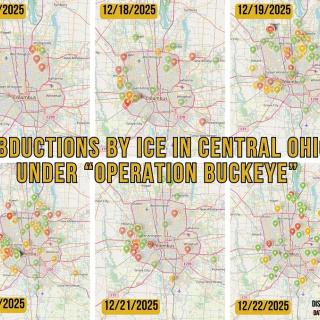Advertisement
The East Side of Columbus – where the Columbus we know now was essentially born – has been much maligned during this modern era. No doubt calls for improvement have been echoing for some time.
The city has done plenty to facilitate the Short North. More recently attention and infrastructure funding have turned to Franklinton and South Linden.
East Side residents from the Near East to Eastmoor and out to Eastland Mall are saying, once again, don’t leave us behind.
“The city when it comes to the East Side, the plan is all very piecemeal, and frankly, half-assed. That is the only way to put it,” says Michelle Santuomo, former president of the Eastmoor Civic Association, representing the neighborhood between Bexley and Whitehall. “There’s so much that needs to get done. The city has ignored us. And I have gone down to City Council and made fools of them whenever they do their budgets. I say, ‘Where’s the money for the East Side?’
But others contend efforts to make serious improvement to the East Side were initiated and are moving along. Consider how OSU, the Columbus Metropolitan Housing Authority and the city, a decade ago initiated PACT, or Partners Achieving Community Transformation, to affect the Near East Side
Those who approve of the PACT argue that it transformed and saved Poindexter Village, keeping its affordable housing intact – all made possible with a $30 million HUD grant, matched by $30 million from the city for infrastructure
PACT has also provided 31 Near East homeowners up to $10,000 for exterior home repairs and initiated a homeownership incentive program helping 28 OSU employees purchase a home with down-payment assistance.
“I think the city has done a tremendous amount of investment for the Near East Side. Even prior to PACT, the City of Columbus is the reason why 750 East Long building was built. Why the Lincoln Theatre was restored. I can’t name another neighborhood that has had that level of investment,” says Autumn Glover, interim president of PACT. “Thirty-million dollars for infrastructure (at Poindexter) alone is not something I’ve seen in another urban neighborhood, or any neighborhood, to be candid. Both Mayor Coleman and Mayor Ginther have sustained a commitment to the Near East Side.”
Conversely, the Free Press covered the two-year long fight on the Near East over Poindexter Village: “The PACT destroyed Poindexter Village in order to ‘save it,’” states Bob Fitrakis, Near East Area Commissioner and Free Press Editor, “The PACT tore down magnificent all-brick public housing that was at the center of the black community on the East Side.”
Free Press writer Julie Whitney Scott wrote that PACT’s treatment of Poindexter Village was not only the destruction of a neighborhood but of black history on the Near East Side. Despite community protest, forums, and demonstrations, the PACT prevailed.
In 2012 a panel of historical experts recommended to Columbus’ Historical Preservation Office that ten Poindexter buildings be saved and repurposed. The PACT, without input from the community, demolished all but two. The displaced black residents were dispersed to other parts of Columbus and suburbs, some as far away as Lancaster.
Kathleen Bailey is the chair for the city-sponsored Near East Side Commission, a liaison for residents, developers and city officials. Bailey scoffs at the city’s effort to revitalize the Near East, saying it’s not a “comprehensive” effort
“Comprehensive development is the city getting behind private developers and telling them we are going to do several blocks, fix the streets, and the infrastructure, do the whole area. Don’t come in here and fix one house here, and one house there,” says Bailey a resident of the Near East since 1984. “How do you think they fixed the Short North?”
Bailey says comprehensive development has come to West 5th (Grandview), and is coming to Franklinton and South Linden.
“The city has already decided where they want to do stuff and we are not part of it,” she said. “We are not that neighborhood. For whatever reasons.”
She admits the city hasn’t completely turned a cold shoulder to the Near East. But she feels the city’s commitment is not wholehearted.
Soon after the Lincoln Theatre was restored in 2009, Bailey recalls speaking to a then-Mayor Coleman staffer who had come out to the Near East promoting a city tax increase that would appear on the next ballot
“I asked him, ‘Why should we vote for a tax increase?’ He said, ‘Well, you got the Lincoln Theatre.’ In other words, he was telling me, ‘We did something for you, so why don’t you shut up and enjoy it.’”
That’s basically the message to the entire East Side, says Bailey
“We gave you one or two nice things, so just be happy and go about your business,” she says
Perhaps the recent vote by Columbus City Council approving $20 million to rebuild the Hamilton Road corridor across from the Eastland Mall is a telltale sign of how the East Side has historically been treated. Some of the money will be used to build sidewalks, of all things, as many residents said they have been needed for decades
Santuomo says Hamilton Road isn’t the only East Side corridor that for years has been dangerous for drivers and pedestrians.
“James Road between 5th and I-70,” she pointed out. “No sidewalks on one side. Only one light to cross between Main and Broad. It is poorly lit, and the intersection of James and Broad has been ranked either first, second, or third as the state’s most dangerous intersection of the state over the previous 20 years. Yet they fail to fix it.”
The city could be planning great things for the East Side, like sidewalks and safe intersections. Over the summer, Columbus City Council approved the formation of the Mideast Civic Association as the city’s latest area commission, which has brought together a host of neighborhood associations.
Santuomo says she’s waited long enough for change
“[City Council’s] blatant ignoring of the lack of funding of the East Side is infuriating,” she says.



